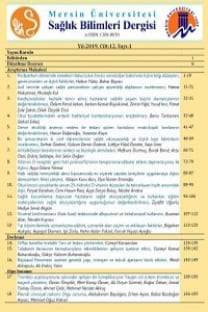Visseral Leishmaniasis (Kala Azar) tedavisinde allopurinol ve ketakonazol kullanımı
Leishmania tedavisi, allopürinol, ketakonasol
Treatment of Viscelar Leishmaniasis the Use of allopurinol and ketoconazole
Leishmania treatment, alloprurinol, ketakonasol,
___
- 1. Wilson ME. Leishmaniasis. Curr Opin Infect Dis 1993; 6: 331-341.2. Wittner M. Leishmaniasis. In: Feigin RD, Cherry JD. Textbook of pediatric infectious disease. Philedelphia: W.B. Saunders Company 1998: 2452-2458.3. Guerin PJ, Olliaro P, Sundar S et al. Visceral leishmaniasis: current status of control, diagnosis and treatment and a proposed research and development agenda. Lancet İnfect Dis 2002; 2: 494-501.4. Aronson NE, Wortmann GW, Johnson SC et al. Safety and efficacy of intravenous sodium stibogluconate in the treatment of leishmaniasis: recent U.S. military experience. 5. Hepburn NC, Nolan J, Herd RM, Neilson JM, Sutherland GR. Cardiac effects of sodium stibogluconate: myocardial, electrophysiological and biochemical studies. Q J Med 1994; 87: 465-472.6. Catania S, Aiassa C, Izathzoglou S, et al. Visceral leishmaniasis treated with liposomal amphotericin B. Pediatr Infect Dis J 1999; 18: 73-74.7. Sundar S, Thakur CP, Ehgel J et al. Oral miltefosine for İndian visceral leishmaniasis. N. Eng J Med 2002; 347: 1739-1746. 8. Herwald BL, Berman JD. Recommandations for treating leishmaniasis with sodium stibogluconate(Pentostam) and rewiev of the pertinent clinical studies. Am J Trop Med Hyg 1992; 46: 296-306.9. Kuyucu N, Kara C, Bakirtaç A, Teziç T. Successful treatment of visceral leishmaniasis with allopürinol plus ketoconazole in an infant who developed pancreatitis caused by meglumine antimoniate. Pediatr Infect Dis J 2001; 20:456-458.10. Lee MB, Gilbert HM. Current approaches to leishmaniasis. Infect Med 1999;16:37-45.11. Berman JD: Human leishmaniasis: clinical, diagnosis and chemothrepuetic developments in the last 10 years. Clin Infect Dis 1997; 24: 684-703.12. Seaman J, Boer C, Wilkinson R, et al. Liposomal amphotericin B (Ambisome) in the treatment of complicated kala-azar under field conditions. Clin Infect Dis 1995; 21:188-193.13. Kager PA, Rees PH, Wellde BT, Hockmeyer WT, Lyerly WH. Allopürinol in the treatment of visceral leishmaniasis. Trans R Soc Trop Med Hyg 1981; 75: 556-559.14. Ragusa R, Di Cataldo A, Sanperi P, Schiliro G. Treatment of visceral leismaniasis with meglumine and allopürinol. Am J Dis Child 1993; 147: 611-612.15. Wali JP, Aggarwal P, Gupta U, Saluja S, Singh S. Ketocanozole in treatment of visceral leismaniasis. Lancet 1990; 336: 810-811.16. Wali JP, Aggarwal P, Gupta U, Saluja S, Singh S. Ketocanozole in the treatment antimony-and pentamidine resistant kala-azar. J Infect Dis 1992; 166: 215-216.17. Sundar S, Kumar K, Singh VP. Ketocanozole in visceral leismaniasis. Lancet 1990; 336: 1582-1583. 18. Halim MA, Alfurayh O, Kalin ME, Dammas S, Al-Eisa A, Damanhouri G. Successful treatment of visceral leishmaniasis with allopürinol plus ketocanozol in renal transplant recipient after the occurence of pancreatitis due to stibogluconate. Clin Infect Dis 1993; 16: 397-399.19. Torrus D, Massa B, Boix V, Portilla J, Perez-Mateo M. Meglumine antimonate-induced pancreatitis. Am J Gastroenterol 1996; 91: 820-821.20. Huesa M, Bover J, Seron D, et al. The renal transplant patient with visceral leishmaniasis who could not tolerate meglumine antimonate: cure with ketocanozole and allopürinol. Nephrol Dial Transplant. 1999;14(12):2941-2943.
- Yayın Aralığı: 3
- Başlangıç: 2008
- Yayıncı: Mersin Üniversitesi Sağlık Bilimleri Enstitüsü
Demir eksikliği anemisi nedeni ile tedavi gören hastaların endoskopik tanılarının değerlendirilmesi
Serhat ÖZDENK, Gülcan DEMİR ÖZDENK, Lütfiye Hilal ÖZCEBE, Sarp ÜNER
Özlem PERSİL ÖZKAN, Serkan Kemal BÜYÜKÜNAL, Zerrin YİĞİT, Yusuf İNCİ, Fitnat Şule ŞAKAR, Dilek ÖZÇELİK ERSÜ
Plevral sinoviyal sarkom: Olgu sunumu
Abdulkerim Bayülgen, Erhan Ayan, Rabia BOZDOĞAN ARPACI, Mehmet Oğuz Köksel
Okul tuvaletlerindeki enterik bakteriyel kontaminasyonun araştırılması
Özcan ÖRSÇELİK, Mert Koray ÖZCAN, Ali Orçun SÜRMELİ, Buğra ÖZKAN, İsmail Türkay ÖZCAN, Ahmet ÇELİK, Mehmet Necdet AKKUŞ
Ziyafet UĞURLU, Hediye Seval AKGÜN
Tıp öğrencilerinde uzmanlaşma eğilimi, uzmanlık alan seçimi ve etkileyen faktörler
Bilgehan AÇIKGÖZ, Ayşegül EKEMEN, İşıl ZORLU, Nehir Aslan YÜKSEL, Ferruh Niyazi AYOĞLU
Aril(alkil)azol türevlerinin sentezi ve biyolojik aktiviteleri
Mefkure DURMUŞ, Burak BARUT, Arzu ÖZEL, Erdinç SELLİTEPE, İnci Selin DOĞAN
